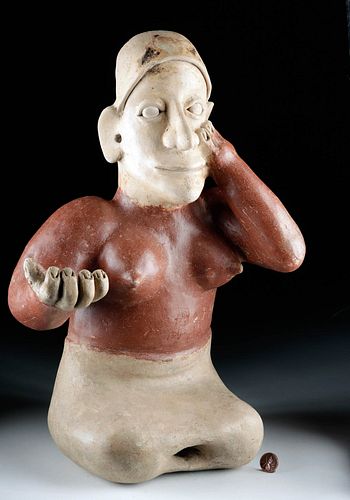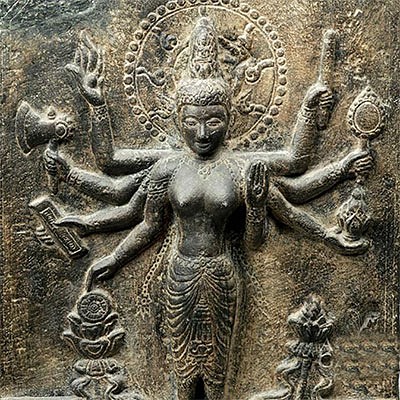Large Jalisco Ameca Pottery Seated Female Figure
Lot 155
About Seller
Artemis Fine Arts
686 S Taylor Ave, Ste 106
Louisville, CO 80027
United States
Selling antiquities, ancient and ethnographic art online since 1993, Artemis Gallery specializes in Classical Antiquities (Egyptian, Greek, Roman, Near Eastern), Asian, Pre-Columbian, African / Tribal / Oceanographic art. Our extensive inventory includes pottery, stone, metal, wood, glass and textil...Read more
Categories
Estimate:
$4,500 - $6,500
Absentee vs Live bid
Two ways to bid:
- Leave a max absentee bid and the platform will bid on your behalf up to your maximum bid during the live auction.
- Bid live during the auction and your bids will be submitted real-time to the auctioneer.
Bid Increments
| Price | Bid Increment |
|---|---|
| $0 | $25 |
| $300 | $50 |
| $1,000 | $100 |
| $2,000 | $250 |
| $5,000 | $500 |
| $10,000 | $1,000 |
| $20,000 | $2,500 |
| $50,000 | $5,000 |
| $100,000 | $10,000 |
| $200,000 | $20,000 |
About Auction
By Artemis Fine Arts
Feb 4, 2021
Set Reminder
2021-02-04 10:00:00
2021-02-04 10:00:00
America/New_York
Bidsquare
Bidsquare : CLEARANCE Asian | Antiquities | Ethnographic
https://www.bidsquare.com/auctions/artemis-gallery/clearance-asian-antiquities-ethnographic-6361
Featuring discounted pricing on Asian art, classical antiquities from Egypt, Greece, Italy, and the Near East...plus Pre-Columbian, Tribal, Russian Icons, Spanish Colonial, Fine Art, more! Starting prices have been reduced up to 65% from original auction prices - perfect for dealers and collectors! Artemis Fine Arts info@artemisgallery.com
Featuring discounted pricing on Asian art, classical antiquities from Egypt, Greece, Italy, and the Near East...plus Pre-Columbian, Tribal, Russian Icons, Spanish Colonial, Fine Art, more! Starting prices have been reduced up to 65% from original auction prices - perfect for dealers and collectors! Artemis Fine Arts info@artemisgallery.com
- Lot Description
**Originally Listed At $2800**
Pre-Columbian, West Mexico, Jalisco, Ameca type, Protoclassic Period, ca. 100 BCE to 250 CE. An exceptional hollow-bodied pottery female statue depicted kneeling with a skirt covering her thighs. She leans slightly forward and has globular breasts, immense shoulders, one arm held out with an open palm, and the other arm touching her face, each hand with veristic fingers and nails. A thick neck holds aloft a sizable head with spherical eyes set within thick lids, a massive nose above full lips and a pointed chin, and pierced tab-shaped ears, all beneath a simple cap. Her head and lower body are accentuated with smooth cream-hued slip, and much of her arms and upper body exhibit deep red slip which imbues her with a lovely presentation evocative of ancient West Mexico! Size: 11.25" W x 16.2" H (28.6 cm x 41.1 cm).
West Mexican shaft tomb figures like this example derive their names from the central architectural feature that we know of from this culture. Jalisco, located on Mexico's southwestern coast, was part of the shaft tomb culture during this time, along with neighbors in nearby Colima and Nayarit. These people would build generally rectangular vertical or near-vertical shafts down from the ground level - usually about 3 to 20 meters deep - through tepetate, the volcanic tuff that makes up the geology of the region, to narrow horizontal tunnels that led to one or more vaulted or rounded burial chambers.
These shafts were almost always dug beneath a dwelling, probably a family home, and seem to have been used as family mausoleums, housing the remains of many related individuals. Figures like this one were placed into the tombs; researchers believe that they were placed around the edges facing inward, as if in conversation with the dead. Grouped with other figures, and alongside clay bowls, and boxes, figures like this one were positioned around the body (or bodies), near the skull.
Unfortunately, we lack the necessary information to fully understand what these figures were made for - Did they represent everyday people, even individuals? Were they religious? Were they created to mediate between the living and the dead? Whatever their purpose, today they are beautiful artwork and reminders of the mysterious past.
A stylistically-similar example of a larger size hammered for $15,000 at Sotheby's, New York "African, Oceanic and Pre-Columbian Art Including Property from the Krugier and Lasansky Collections" auction (May 16, 2014, lot 261): http://www.sothebys.com/en/auctions/ecatalogue/2014/african-oceanic-n09146/lot.261.html
Provenance: ex-private Los Angeles, California, USA collection; ex-Arte Primitivo Gallery, New York, New York, USA; ex-private southern California, USA collection; ex-private old Tucson, Arizona, USA estate collection, collected in the 1970s
All items legal to buy/sell under U.S. Statute covering cultural patrimony Code 2600, CHAPTER 14, and are guaranteed to be as described or your money back.
A Certificate of Authenticity will accompany all winning bids.
We ship worldwide and handle all shipping in-house for your convenience.
#145672Restoration to some age fissures on the skirt and legs. Repair to a couple of fingers, with minor abrasions and nicks to legs, body, arms, and head, and light fading to original pigmentation. Nice earthen deposits and craquelure to original pigmentation throughout.Condition
- Shipping Info
-
All shipping is handled in-house for your convenience. Your invoice from Artemis Gallery will include shipping calculation instructions. If in doubt, please inquire BEFORE bidding for estimated shipping costs for individual items.
-
- Buyer's Premium



 EUR
EUR CAD
CAD AUD
AUD GBP
GBP MXN
MXN HKD
HKD CNY
CNY MYR
MYR SEK
SEK SGD
SGD CHF
CHF THB
THB















